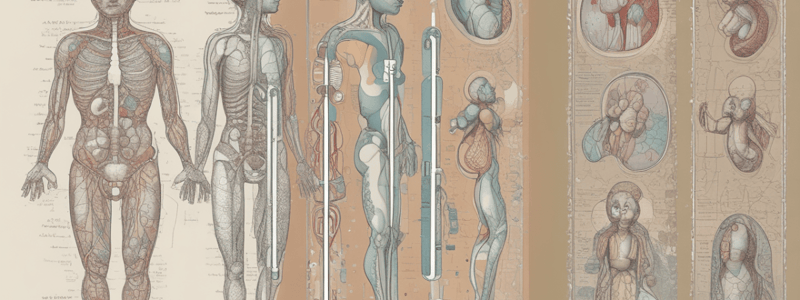Podcast
Questions and Answers
What is the primary purpose of screening newborns?
What is the primary purpose of screening newborns?
- To determine the infant's blood type
- To administer vaccinations
- To monitor the infant's vital signs
- To detect genetic, metabolic, and infectious diseases and disorders (correct)
What is the maximum age of a newborn when the initial blood specimen can be collected?
What is the maximum age of a newborn when the initial blood specimen can be collected?
- 72 hours (correct)
- 1 week
- 24 hours
- 48 hours
What is the next step if the initial specimen is obtained before the newborn is 24 hours old?
What is the next step if the initial specimen is obtained before the newborn is 24 hours old?
- Repeat the test immediately
- Report the results as final
- Obtain a second specimen up to 2 weeks of age (correct)
- Discard the specimen
Which of the following conditions is NOT screened for in newborns?
Which of the following conditions is NOT screened for in newborns?
What is the purpose of the absorbent areas on the filter paper?
What is the purpose of the absorbent areas on the filter paper?
Why should the filter paper not be touched, even with gloved hands?
Why should the filter paper not be touched, even with gloved hands?
What is the method of collection for newborn screenings?
What is the method of collection for newborn screenings?
Why is it essential to include the parent's or guardian's phone number on the form?
Why is it essential to include the parent's or guardian's phone number on the form?
What should be done if the test results are positive?
What should be done if the test results are positive?
What is the importance of ensuring the paperwork or card is filled out completely?
What is the importance of ensuring the paperwork or card is filled out completely?
Why is it necessary to warm the infant's heel before collecting blood?
Why is it necessary to warm the infant's heel before collecting blood?
What should be done with the first drop of blood after puncturing the heel?
What should be done with the first drop of blood after puncturing the heel?
What is the purpose of allowing a large blood droplet to form at the puncture site?
What is the purpose of allowing a large blood droplet to form at the puncture site?
Why should capillary tubes not be used for collecting blood?
Why should capillary tubes not be used for collecting blood?
How should the blood spots be dried after collection?
How should the blood spots be dried after collection?
Why should wet filter papers not touch each other?
Why should wet filter papers not touch each other?
What should be done with the completed collection cards?
What should be done with the completed collection cards?
What is the consequence of not allowing the blood spots to dry thoroughly?
What is the consequence of not allowing the blood spots to dry thoroughly?
Why is it important to avoid blotting or attempting to color in the circle with several blood drops?
Why is it important to avoid blotting or attempting to color in the circle with several blood drops?
What should be done if an infant tests positive for a condition?
What should be done if an infant tests positive for a condition?
The infant's heel should be cleansed with an antibiotic before collecting blood.
The infant's heel should be cleansed with an antibiotic before collecting blood.
A semi-automated lancet device is used to puncture the infant's heel no deeper than 3 mm.
A semi-automated lancet device is used to puncture the infant's heel no deeper than 3 mm.
Capillary tubes can be used to collect blood for newborn screening.
Capillary tubes can be used to collect blood for newborn screening.
The filter paper should be touched to the drop of blood several times to ensure thorough saturation.
The filter paper should be touched to the drop of blood several times to ensure thorough saturation.
Completed collection cards should be mailed to the state laboratories within 7 days of collection.
Completed collection cards should be mailed to the state laboratories within 7 days of collection.
Newborn screenings are required by federal law in the U.S.
Newborn screenings are required by federal law in the U.S.
Biotinidase deficiency is a genetic disorder that can be detected through newborn screening.
Biotinidase deficiency is a genetic disorder that can be detected through newborn screening.
The blood-spot testing for newborn screenings is typically performed after the newborn is 72 hours old.
The blood-spot testing for newborn screenings is typically performed after the newborn is 72 hours old.
Toxoplasmosis is an infectious disease that can be detected through newborn screening.
Toxoplasmosis is an infectious disease that can be detected through newborn screening.
The absorbent areas on the filter paper can expire if not used within a certain timeframe.
The absorbent areas on the filter paper can expire if not used within a certain timeframe.
Flashcards are hidden until you start studying
Study Notes
Newborn Screenings
- Newborns in the U.S. are screened for genetic, metabolic, and infectious diseases and disorders through blood-spot testing
- Screening aids in early detection, diagnosis, and treatment of conditions like cystic fibrosis, hypothyroidism, phenylketonuria (PKU), galactosemia, and other genetic disorders
Blood-Spot Testing
- Blood-spot testing is performed before the newborn is 72 hours old; if the specimen is obtained before 24 hours old, a second specimen should be obtained for screening up to 2 weeks of age
- Blood samples are collected onto specific forms or cards with absorbent areas called filter paper
- It is essential to fill out the forms completely in ink with all required information and check for expiration dates
Collection Procedure
- To perform a heel stick on an infant, the following procedures must be followed:
- Properly identify the infant
- Ensure that the paperwork or card is filled out completely, including parent's/guardian's phone number
- Avoid touching the filter paper part to prevent contamination
- Wash hands and don gloves
- Check the temperature of the infant's heel and warm it if necessary
- Cleanse the infant's heel with an antiseptic and allow the skin to dry
- Puncture the heel with a semi-automated lancet device no deeper than 2 mm
- Wipe off the first drop of blood
- Allow a large blood droplet to form at the puncture site
- Touch the filter paper to the drop of blood to soak through completely in each circle
- Important considerations during collection:
- Avoid using capillary tubes as they can make the filter paper rough and cause overabsorption
- Do not blot or attempt to color in the circle with several blood drops, as it can cause serum rings and alter test results
- Air-dry the blood spots thoroughly for 3 hours at room temperature, away from direct sunlight and heat
Submission and Rejection Criteria
- Completed collection cards should be mailed to the appropriate state laboratories for testing with all required paperwork
- Specimens can be unusable and rejected if:
- A circle is oversaturated
- All circles are not completely filled
- An expired form is used
- The form is not received within 14 days of collection
- The specimen is contaminated with a foreign substance
- The specimen is not allowed to dry thoroughly
- The circles have serum rings
Newborn Screenings
- Newborns in the U.S. are screened for genetic, metabolic, and infectious diseases and disorders through blood-spot testing
- Screening aids in early detection, diagnosis, and treatment of conditions like cystic fibrosis, hypothyroidism, phenylketonuria (PKU), galactosemia, and other genetic disorders
Blood-Spot Testing
- Blood-spot testing is performed before the newborn is 72 hours old; if the specimen is obtained before 24 hours old, a second specimen should be obtained for screening up to 2 weeks of age
- Blood samples are collected onto specific forms or cards with absorbent areas called filter paper
- It is essential to fill out the forms completely in ink with all required information and check for expiration dates
Collection Procedure
- To perform a heel stick on an infant, the following procedures must be followed:
- Properly identify the infant
- Ensure that the paperwork or card is filled out completely, including parent's/guardian's phone number
- Avoid touching the filter paper part to prevent contamination
- Wash hands and don gloves
- Check the temperature of the infant's heel and warm it if necessary
- Cleanse the infant's heel with an antiseptic and allow the skin to dry
- Puncture the heel with a semi-automated lancet device no deeper than 2 mm
- Wipe off the first drop of blood
- Allow a large blood droplet to form at the puncture site
- Touch the filter paper to the drop of blood to soak through completely in each circle
- Important considerations during collection:
- Avoid using capillary tubes as they can make the filter paper rough and cause overabsorption
- Do not blot or attempt to color in the circle with several blood drops, as it can cause serum rings and alter test results
- Air-dry the blood spots thoroughly for 3 hours at room temperature, away from direct sunlight and heat
Submission and Rejection Criteria
- Completed collection cards should be mailed to the appropriate state laboratories for testing with all required paperwork
- Specimens can be unusable and rejected if:
- A circle is oversaturated
- All circles are not completely filled
- An expired form is used
- The form is not received within 14 days of collection
- The specimen is contaminated with a foreign substance
- The specimen is not allowed to dry thoroughly
- The circles have serum rings
Studying That Suits You
Use AI to generate personalized quizzes and flashcards to suit your learning preferences.




